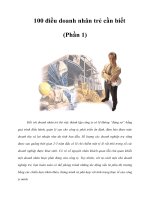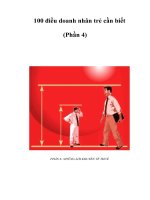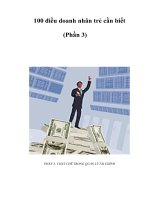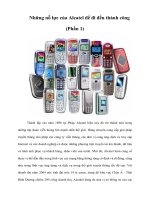Invent Business Opportunities No One Else Can Imagine phần 1 ppt
Bạn đang xem bản rút gọn của tài liệu. Xem và tải ngay bản đầy đủ của tài liệu tại đây (207.35 KB, 20 trang )
Invent Business
Opportunities
No One
Else Can Imagine
Invent Business
Opportunities
No One
Else Can Imagine
Trendsetting companies
disarm their competition
and
astound their customers.
Will you be one of them?
by Art Turock
Franklin Lakes, NJ
Copyright © 2002 by Art Turock
All rights reserved under the Pan-American and International Copyright Con-
ventions. This book may not be reproduced, in whole or in part, in any form or
by any means electronic or mechanical, including photocopying, recording, or by
any information storage and retrieval system now known or hereafter invented,
without written permission from the publisher, The Career Press.
I
NVENT BUSINESS OPPORTUNITIES NO ONE ELSE CAN IMAGINE
Edited by Nicole DeFelice
Typeset by John J. O’Sullivan
Cover design by Greg Wilkin
Printed in the U.S.A. by Book-mart Press
To order this title, please call toll-free 1-800-CAREER-1 (NJ and Canada:
201-848-0310) to order using VISA or MasterCard, or for further information
on books from Career Press.
The Career Press, Inc., 3 Tice Road, PO Box 687,
Franklin Lakes, NJ 07417
www.careerpress.com
Library of Congress Cataloging-in-Publication Data
Turock, Art, 1950-
Invent business opportunities no one else can imagine / by Art Turock.
p. cm.
Includes index.
ISBN 1-56414-578-6
1. Business planning. 2. Strategic planning. I. Title.
HD30.28 .T825 2001
658.4’012 dc21 200135363
Acknowledgments
Randy Howatt, who fi rst saw the value of my ideas and without
whose encouragement, this book would never have been written.
When a leader has earned membership in Young Presidents’ Organi-
zation and World Presidents’ Organization, his opinion carries clout.
My team of book reviewers, who gave generously of their time
and their expertise in providing incredibly helpful feedback. Thanks
to Bob Swellie of American Greetings, Jack Kopnisky, President of
Key Bank, Andy Eckert of Storecast Merchandising Corporation,
Dr. Linne Bourget of the Institute of Transformational Leadership,
Bob Peters, Managing Partner with KPMG, Robert Holmes, CEO of
Harbor Properties, Bruce Pettet, CEO of TARE7, and Karen Holt,
Founder of Colores.
Selma Turock, my mother, who instilled the incredible gift of
never settling for less than what I truly desire in life.
Haley Ashland, my wife and best friend, who is the constant stim-
ulus for new learning in our business and our relationship.
Mary Lynne Hanley, of Maystar Communications, who in a mem-
orable three week period gave incredible passion, energy, and impecca-
ble judgment in the transformative editing of my original manuscript.
Dr. Henriette Klauser of Writing Resources, who offered excep-
tional savvy and skill in the preparation of my book proposal and in
connecting with my excellent literary agent, Jane Dystel.
Contents
• 7 •
Chapter 1:
Gaining a Sustainable Advantage
“What are the challenges in sustaining a competitive advantage?” 9
Chapter 2:
Job # 1—Inventing the Future
“How do you do manage for the short term,
while also innovating for the future?” 21
Chapter 3:
The Jerry Garcia Principle
“How do you become known as ‘the only one to do what you do?’” 45
Chapter 4:
Detect Latent Needs
“How do you give customers what they need
but might never even think to ask for?” 73
Chapter 5:
Fresh Eyes
“What are the best out-of-the-box thinking methods
for conceiving novel business opportunities?” 89
Chapter 6:
The Power of Questions
“What are the provocative questions that trendsetters
use to devise their original strategies?” 119
Chapter 7:
Fearlessness Breeds Freedom
“What are the core beliefs that distinguish trendsetting leaders?” 137
Chapter 8:
The Spirit of the Garage
“How do you develop a culture
where strategic innovation fl ourishes?” 155
Chapter 9:
Strategic Planning for Innovators
“How do you rethink strategic planning
so you produce bold innovations?” 179
Epilogue:
Unleashing Entrepreneurial Freedom 205
Index 211
About the Author 219
Chapter
1
Gaining a Sustainable Advantage
Gaining a Sustainable Advantage
• 11 •
Chapter
1
“Two roads diverged in a wood, and I—
I took the one less traveled by,
And that has made all the difference.”
—from the poem “The Road Not Taken” by Robert Frost
M
ost of us have no idea of the powerful infl uence the past
exerts on our choices and actions today. No idea. Not even
close.
Why have titans such as IBM, Sears, AT&T, and General
Motors “hit a wall” somewhere along the marathon of shap-
ing their business destiny? Could it be
that winning companies are now threat-
ened by a hidden disadvantage that isn’t
shared by their middling competitors?
The disadvantage is not complacency.
Successful business leaders are already
alert to the threat of complacency. No,
they are plagued by a disadvantage that
defi es detection because it is imbedded within the best practices that were
immensely effective in the past—their winning formula.
How can successful companies lose with a winning formula? Don’t
they have ample evidence of success—solid sales, market share, profi t-
ability, quality measures, and customer satisfaction data? They know what
works. Surely the numbers don’t lie.
When business is on a roll, the logical strategy is to repeat the win-
ning formula. When results plateau or nosedive, it only seems rational
to push the winning formula harder and harder. But the shelf life of
?????
What are the challenges
in sustaining a competitive
advantage?
Invent Business Opportunities No One Else Can Imagine
12
winning formulas gets shorter and shorter. The rules of competition change.
Now time-honored techniques may yield only “antiquated” excellence—high
quality products and services that the marketplace no longer prizes. The
value offering is excellent—for yesterday’s customer.
Will doing more of what brought you success in the past bring about
the future you desire? In growing numbers, senior executives are realizing
a painful truth—no company, regardless of size, wealth, reputation, or
market share, can rely on doing what worked in the past. Sustained suc-
cess now demands the creation of new sources of competitive advantage.
It requires innovation.
Recent history offers compelling evidence of the power of innovation
in achieving sustainable advantage. Between 1986 and 1996, only 17 mem-
bers of the Fortune 1000 grew their total shareholder returns by 35 percent
or more per year. This superstar list includes Amgen, Conseco, Harley-
Davidson, Home Depot, Nike, Oracle and Pacifi care Health Systems. Far
beyond product and service upgrades, these wealth creators focused on
inventing new industries or remaking the rules of competition in their
existing markets. Sustainable competitive advantage goes to companies
that discover opportunities no one else—neither their customers nor their
competitors—can imagine.
So what is the barrier? If we know we need to innovate, why aren’t
more companies doing it? Why does nearly every industry have only a
handful of trailblazers, while the rest plod along in the same ruts they’ve
plowed for decades?
The Fatal Assumption
An often hidden assumption underlies most business strategies, one
that feeds on time-honored faith in the eternal effi cacy of a winning
formula. It’s rarely easy to recognize, especially when a business is on a
profi t-making roll. But I must expose this shadowy supposition for what it
actually is: an absolutely fatal assumption.
Here’s how many businesses express this Fatal Assumption: The strate-
gies that brought us success in the past will inevitably continue to work in the future, as
long as we just implement them better and/or with greater effort.
Why is this assumption is fatal? Because it just doesn’t fi t today’s ever-
changing business environment.
Gaining a Sustainable Advantage
13
Many have diffi culty acknowledging the Fatal Assumption, especially when
a business is still profi table. Indeed, the brave souls that dare openly to wonder
whether the winning formula is still working are few and far between.
Even as the pace of change peaks in most industries, most of us fi nd it
easier, and often safer, to blame a variety of “culprits,” or indulge in denial and
wishful thinking—anything but confront the demise of our winning formula.
We yearn for the golden days when we could milk the cash cow product for
years, instead of months, without having to commit to any sort of change…or
even talk about changing anything.
We watch e-commerce take hold in other industries and hope our industry
will somehow get by unscathed.
Even though we keep raising our performance standards, our competitors
are also doing such high quality work that customers can scarcely differentiate.
We maintain our traditional low-price strategy even as new mega-giant
competitors use their economies of scale to whittle down prices to a level we
can’t afford to match.
We hold off from investing in a promising innovation because none of our
competitors has fi gured out how to do it profi tably, and we don’t dare go fi rst.
Does any of this sound familiar? When you are at a strategic cross-
roads, it is not easy to confront the need for innovation and change. It is,
indeed, “the road less traveled.”
The dangerous compromise
Why is there such reluctance to embrace the obvious solution—inno-
vation? Most business leaders are not convinced they have to pursue bold
innovation to the degree that is required today. They don’t recognize the
increasing demand for original thinking that is required just to keep pace,
let alone lead a market. Consequently, insuffi cient effort is made to develop
the strategies and organizational culture where innovation can fl ourish. Ulti-
mately, the Fatal Assumption produces a dangerous compromise—settling
for short-term profi tability instead of playing for a sustainable competitive
advantage.
We are witnessing a fundamental divergence in the pathway to com-
petitive advantage. Between 1925 and 1985, the business environment was
tranquil compared to today’s turbulence. In the book, Marketing Warfare,
Invent Business Opportunities No One Else Can Imagine
14
strategists Al Ries and Jack Trout cite a study of leading brands (e.g., Ivory in
soap, Campbell in soup, Coca-Cola in soft drinks) in 25 different industries.
Twenty of the 25 market leaders in 1925 were still on top 60 years later.
During this period, the Fatal Assumption refl ected business realities.
Industry boundaries remained intact. Competitors were well known and
came from within one’s own industry, rarely from other industries. Market
leaders set the rules and used their unfair advantages to ward off, even
destroy, competition. Product innovation was an advantage that took years
for a competitor to emulate. The supply channel of manufacturers, whole-
salers, and distributors had well-defi ned and intact roles. Customers were
less knowledgeable, less demanding, and less diverse in their needs than
they are today. There was no Internet. In such a relatively tranquil market,
strategy tweaking and incremental change were suffi cient to stay ahead.
Strategic makeover was overkill.
Those pre-1985 market conditions are gone, replaced by globalization,
computerization, consolidation, and deregulation. As they confront change
and the need for a new strategy, companies choose one of two distinct
models.
Replicator companies retain their faith in the Fatal Assumption. Con-
sequently, they have excessive reverence for their winning formula. Rather
than initiate bold innovation, replicators focus on improving quality, exert-
ing more vigorous effort, or making slight adjustments to their basic stra-
tegic moves.
Casting aside the Fatal Assumption, trendsetter companies analyze
the continuing effectiveness of even their most sacred winning formulas.
Trendsetters realize their talent for original thinking is a formidable advan-
tage when used to produce business opportunities that no one else could
imagine.
Although the rest of this book will expand on how to develop the win-
ning ways of trendsetters, let’s spend a little more time now comparing the
characteristics of replicators and trendsetters.
Replicators and Trendsetters
Replicators come in two types: conformists and copycats. Conform-
ists enshrine themselves in a profi table niche with a simple game plan:
Gaining a Sustainable Advantage
15
Stick with the familiar core business, ask customers what they want, make
requested improvements. The conformists’ motto is: “continuous improve-
ment is as good as we need to be.”
Copycats are those “me-too” companies whose strategy is simply to
keep pace with their competition’s emerging innovations. Essentially, if a
competitor’s innovation succeeds, copycats soon adopt it.
The common threat in both breeds of replicators is that neither is
doing any thinking for themselves. Either the strategy is inherited from the
previous senior management team and is adopted with minor tweaking, or
it is copied from a hot competitor’s strategic moves. The lack of original
thinking is evident in the resulting strategy: replicators create a future that
amounts to bringing the past forward.
The pursuit of entrepreneurial freedom
In contrast, trendsetters design strategies that depend on original
thinking.
One group of trendsetters—“innovation catalysts”—conceive new
products, services, and business models. Their goal is to reap the sales
growth, profi tability and brand equity benefi ts that come from being fi rst
to market.
The second type of trendsetters—“best of the best”—are happy to
let others be fi rst, but eventually they perfect the innovation better than its
originator. “Best of the best” trendsetters capitalize on their superior abil-
ity to see the full implications of a primitive but promising idea and their
greater capacity for introducing innovation to the marketplace.
Both trendsetter strategies depend on highly original strategic think-
ing. As a by-product, customers receive products and services they’ve
never before experienced, or have never thought to request. Trendsetters
literally create new marketplace demand, and accelerate the emergence
of an unprecedented future. Their visions become our realities: Personal
computers on every offi ce desktop, plastic credit cards replacing paper
money, and wireless telecommunications all began in the minds of industry
trendsetters and eventually changed the world as we know it. Trendsetters
demonstrate independent thinking and use courageous resolve to pursue
unscripted strategic paths.
Invent Business Opportunities No One Else Can Imagine
16
Because the Fatal Assumption doesn’t infl uence trendsetters, they are
free to exercise a larger range of choices in their quality of thinking and
their actions. I call this expanded capacity for choosing “entrepreneurial
freedom.” An entrepreneur is anyone that manages and assumes the risks
of doing business. The concept can apply to both business owners and
employees who feel a sense of ownership for their slice of the business.
The following distinctions between replicators and trendsetters reveal their
respective ranges of entrepreneurial freedom.
Replicators Trendsetters
Prefer predictability Favor unpredictability that invites
imagination.
Avoid the risk of change Believe the greatest risk is waiting
until circumstances force change.
Are managers who wish Are leaders who shape the future.
to preserve the past
Look for evidence that something Treat mistakes as an integral part of
works, and fear making mistakes the experimentation necessary for
doing anything original.
React to trends. Anticipate trends and accelerate
them.
Accept commoditization as inevitable. Seek to become copy-resistant.
Are concerned about mature markets. Realize market maturity disappears
when new value is introduced.
Look for agreement and view Do what industry incumbents
deviation as dangerous. consider “going too far” and see
conformity as dangerous.
Base business strategy on giving Give customers what they had
customers what they request. never thought of asking for.
Develop strategies based on the Reshape circumstances to propel
dictates of prevailing circumstances. their desired future.
Rely on proven answers. Raise provocative questions that
accelerate learning.
Trendsetters can exercise the replicator choices when market condi-
tions dictate slow and steady change. But when there is a chance to leapfrog
Gaining a Sustainable Advantage
17
the competition, trendsetters have the power to make additional choices
that aren’t available to replicators.
The advantage of focusing on latent needs
Let’s examine the pattern in which a trendsetter’s entrepreneurial free-
dom produces a sustainable advantage. The heart of the trendsetters’
advantage is their extraordinary customer focus. While replicators are con-
tent to ask customers what they want and give it to them, they achieve
lackluster results. Why? Lacking a Jules Verne-like imagination, customers
rarely dream up novel needs. At best, they are content with minor adjust-
ments to existing products and services.
Rather than listening to customers’ direct requests, trendsetters probe
for latent needs that customers can’t express or can’t even imagine being
met.
The ability to recognize and fi nd solutions to latent needs is the most
powerful weapon in the trendsetter’s strategic armory—as revealed in the
unexpectedly innovative strategy of USAA Insurance during the Desert
Storm war.
Even McDonald’s and Coca Cola would envy USAA Insurance’s aston-
ishing share of its market—94 percent. How do they do it? They regulary
break the established insurance underwriting rules and meet the latent needs
of their primary policyholders—military personnel and their families.
During Desert Storm, USAA Insurance offered what no other insur-
ance company in the country was willing to provide. They boosted the life
insurance coverage of troops heading into a combat zone in Iraq, while
retaining the standard rate. New policy holders were accepted even after
they were called to ship overseas.
There’s more. USAA set up a hotline so if a policyholder was killed, the
claimant could make a single phone call for help with the family’s life insur-
ance, property insurance, bank accounts, and investment management.
The USAA Insurance offer refl ected enormous “generosity.” Even
though the company managed its overall risk by placing a cap on how much
life insurance the combatants could buy—$25,000 coverage for lieutenants
and captains, $50,000 for offi cers ranked major or above—its break with
Invent Business Opportunities No One Else Can Imagine
18
industry precedents astounded customers and left its competitors in the
dust. Given the fi rm’s extraordinary support for its active-duty customers,
it is not surprising that USAA attracted the loyalty of 94 percent of its
market segment. That type of sterling reputation is the source of sustain-
able competitive advantage.
The seven big ideas
Based on my 19 years of observing Fortune 500 businesses and mom
’n’ pop operations, I believe that trendsetters’ choices and actions, like
those of USAA Insurance, are the product of an atypical set of ideas they
hold about four factors: strategy, innovative thinking, leadership and orga-
nizational culture. I have summarized these into seven “Big Ideas.”
Businesses that ignore the Big Ideas gradually succumb to the increas-
ing infl uence of the Fatal Assumption and eventually spiral into decline.
Businesses that master the Big Ideas tap into latent needs and invent
opportunities that result in enormous sales growth.
What qualifi es an idea as “BIG?” A Big Idea offers an extraordinary
perspective for interpreting familiar circumstances. Instead of accepting a
few conventional solutions to a dilemma, a fresh perspective allows new
possibilities to emerge, potential solutions that are all but invisible to most
others. Ultimately, each Big Idea brings greater access to the illusive ingre-
dient that propels trendsetters—their unique way of sizing up business
challenges and opportunities.
The purpose of the Seven Big Ideas on page 19 is to weaken the con-
trol exerted by the Fatal Assumption and to restore each business to its full
capacity for entrepreneurial freedom.
Each of the next seven chapters is a detailed discussion of these Big
Ideas.
Are you ready to innovate?
Trendsetters express the transcendent nature of business. They are not
mainly motivated by “show-me-the-money” greed or a “just-enough-to-earn-
a-living” mentality. In my experience, true innovators embark on a daring
journey to manifest their dreams. Along the way, they teach valuable lessons
Gaining a Sustainable Advantage
19
to their employees who have the privilege of participating in such an invig-
orating environment. Trendsetting organizations are learning laboratories
infused by the force of entrepreneurial freedom.
Invent Business Opportunities No One Else Can Imagine is, fi rst and fore-
most, a book about increasing freedom of choice. This freedom of choice
offers business owners and corporate CEOs the opportunity and respon-
sibility to conceive their own business strategies. Additionally, it encourages
employees to share customer insights and propose promising projects in
partnership with their company’s strategists.
While all organizations have the freedom to shape their own destiny,
every organizational leader with bold aspirations must answer these ques-
tions: Are we taking advantage of the entrepreneurial freedom that’s here
for the taking? Are we willing to seize its power or will we settle for squan-
dering it?
• Big Idea #1: Today’s strategic priorities must focus on
innovating for the future rather than improving on the past.
• Big Idea #2: Be the only one that does what you do.
• Big Idea #3: Give customers what they need but might never
even think to ask for.
• Big Idea #4: Observe the familiar with fresh eyes.
• Big Idea #5: Questions are the seeds of innovation.
• Big Idea #6: An organization’s trendsetting capacity is a
refl ection of its leader’s beliefs.
• Big Idea #7: Develop a culture that aligns employee behavior
with the organization’s innovative strategy.









